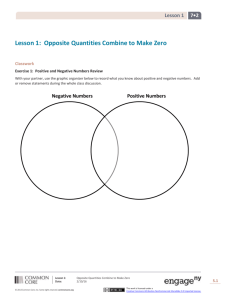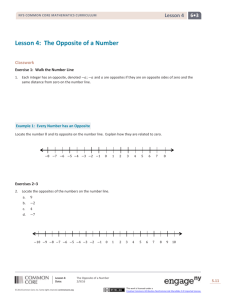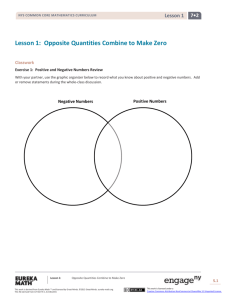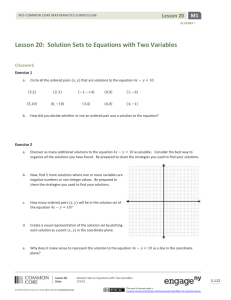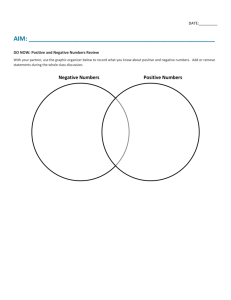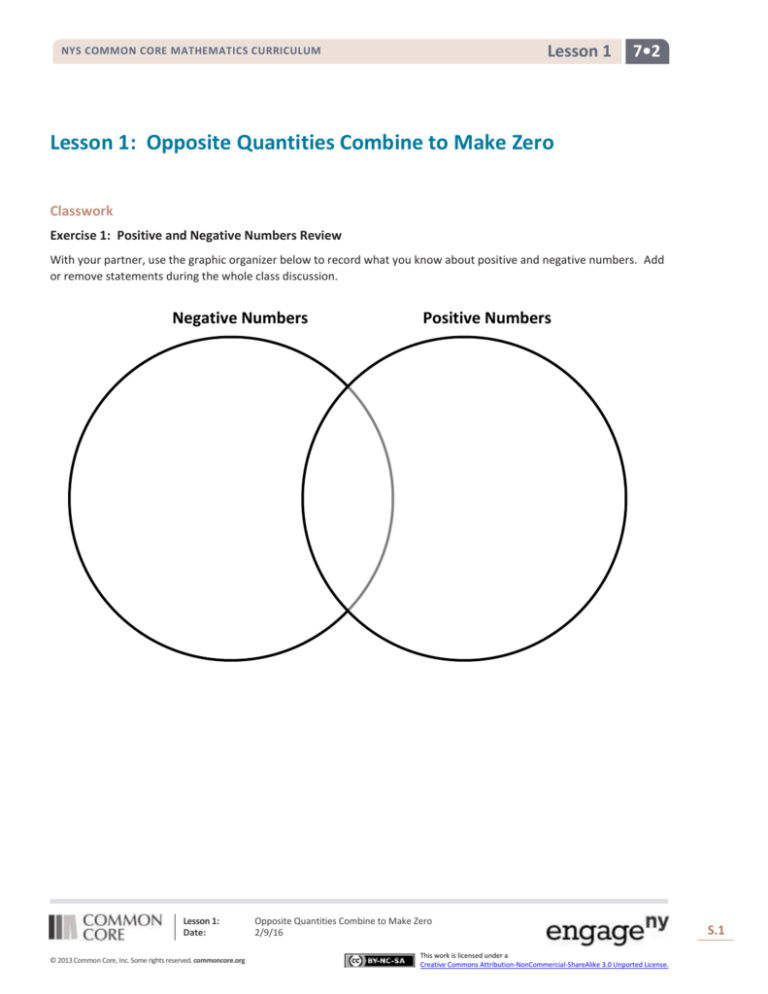
Lesson 1
NYS COMMON CORE MATHEMATICS CURRICULUM
7•2
Lesson 1: Opposite Quantities Combine to Make Zero
Classwork
Exercise 1: Positive and Negative Numbers Review
With your partner, use the graphic organizer below to record what you know about positive and negative numbers. Add
or remove statements during the whole class discussion.
Negative Numbers
Lesson 1:
Date:
© 2013 Common Core, Inc. Some rights reserved. commoncore.org
Positive Numbers
Opposite Quantities Combine to Make Zero
2/9/16
This work is licensed under a
Creative Commons Attribution-NonCommercial-ShareAlike 3.0 Unported License.
S.1
Lesson 1
NYS COMMON CORE MATHEMATICS CURRICULUM
7•2
Example 2: Counting Up and Counting Down on the Number Line
Use the number line below to practice counting up and counting down.
Counting on means ______________________.
Counting up corresponds to ______________________ numbers.
Counting down corresponds to ______________________ numbers.
a.
Where do you begin when locating a number on the number line?
b.
What do you call the distance between a number and 0 on a number line?
c.
What is the relationship between 7 and −7?
Lesson 1:
Date:
© 2013 Common Core, Inc. Some rights reserved. commoncore.org
Opposite Quantities Combine to Make Zero
2/9/16
This work is licensed under a
Creative Commons Attribution-NonCommercial-ShareAlike 3.0 Unported License.
S.2
Lesson 1
NYS COMMON CORE MATHEMATICS CURRICULUM
7•2
Example 3: Using the Integer Game and the Number Line
What is the value of the sum of the card values shown? Use the counting on method on the provided number line to
justify your answer.
5
-5
-4
8
a.
What is the final position on the number line? ________________________________
b.
What card or combination of cards would you need to get back to 0? _____________________________
c.
How should arrows line up when counting on? ____________________________________________________
Exercise 2: The Additive Inverse
Use the number line to answer each of the following:
a.
How far is 7 from 0 and in which direction?
_______________________________
b.
What is the opposite of 7?
_______________________________
c.
How far is −7 from 0 and in which direction?
_______________________________
Lesson 1:
Date:
© 2013 Common Core, Inc. Some rights reserved. commoncore.org
Opposite Quantities Combine to Make Zero
2/9/16
This work is licensed under a
Creative Commons Attribution-NonCommercial-ShareAlike 3.0 Unported License.
S.3
Lesson 1
NYS COMMON CORE MATHEMATICS CURRICULUM
7•2
d.
Thinking back to our previous work, how would you use the counting on method to represent the following: While
playing the Integer Game, the first card selected is 7 and the second card selected is −7?
e.
What does this tell us about the sum of 7 and its opposite, −7?
f.
Look at the curved arrows you drew for 7 and −7. What relationship exists between these two arrows that would
support your claim about the sum of 7 and −7?
g.
Do you think this will hold true for the sum of any number and its opposite?
For all numbers 𝒂 there is a number – 𝒂, such that 𝒂 + (−𝒂) = 𝟎.
The additive inverse of a real number is the opposite of that number on the real number line. For example, the
opposite of −𝟑 is 𝟑. A number and its additive inverse have a sum of 0. The sum of any number and its opposite is
equal to zero.
Exercise 3: Playing the Integer Game
Play the Integer Game with your group. Use a number line to practice counting on.
Lesson 1:
Date:
© 2013 Common Core, Inc. Some rights reserved. commoncore.org
Opposite Quantities Combine to Make Zero
2/9/16
This work is licensed under a
Creative Commons Attribution-NonCommercial-ShareAlike 3.0 Unported License.
S.4
Lesson 1
NYS COMMON CORE MATHEMATICS CURRICULUM
7•2
Lesson Summary
Add positive integers by counting up and add negative integers by counting down.
An integer plus its opposite sum to zero.
The opposite of a number is called the additive inverse because the two numbers’ sum is zero.
Problem Set
For Questions 1–3, refer to the Integer Game.
1.
You have two cards with a sum of (−12) in your hand. What two cards could you have?
2.
You add two more cards to your hand, but the total sum of the cards remains the same, (−12). Give some different
examples of two cards you could choose.
3.
Choose one card value and its additive inverse. Choose from the list below to write a real-world story problem that
would model their sum.
4.
a.
Elevation: above and below sea level
b.
Money: credits and debits, deposits and withdrawals
c.
Temperature: above and below 0 degrees
d.
Football: loss and gain of yards
On the number line below, the numbers h and k are the same distance from 0. Write an equation to express the
value of ℎ + 𝑘.
0
h
5.
k
During a football game, Kevin gained five yards on the first play. Then he lost seven yards on the second play. How
many yards does Kevin need on the next play to get the team back to where they were when they started? Show
your work.
Lesson 1:
Date:
© 2013 Common Core, Inc. Some rights reserved. commoncore.org
Opposite Quantities Combine to Make Zero
2/9/16
This work is licensed under a
Creative Commons Attribution-NonCommercial-ShareAlike 3.0 Unported License.
S.5
Lesson 1
NYS COMMON CORE MATHEMATICS CURRICULUM
6.
7•2
Write an addition number sentence that corresponds to the arrows below.
Lesson 1:
Date:
© 2013 Common Core, Inc. Some rights reserved. commoncore.org
Opposite Quantities Combine to Make Zero
2/9/16
This work is licensed under a
Creative Commons Attribution-NonCommercial-ShareAlike 3.0 Unported License.
S.6

